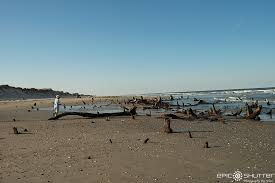Outer Banks Beaches. Living with the Ocean #3
- Denis Raczkowski
- Apr 4, 2020
- 3 min read
In this series of blogs I am reviewing how the Outer Banks of North Carolina, a string of barrier islands, interact with the sea. The relationship creates a constant renewal of the island as it "rolls" over on itself over millions of years. The process is fairly complicated and is reviewed below:
· Waves move offshore sandbars toward the beach expanding its width.
· Beach width contributes to the building of coastal dunes, a common land form at the back of beaches. The wider the beach, the wider and larger the dune that is constructed from winds blowing sand and sediments landward from the beaches, sand and sediment that is trapped by ground vegetation (e.g. sea oats.)
· Dunes defend an island from significant weather events (e.g. hurricanes and northeasters) that produce ocean storm wave attacks. In the face of such wave attacks, dunes “retreat” and migrate landward to diminish the zone of wave impact.
· Coupled with rising sea levels, storm wave attacks potentially could exceed a dune's elevation. This extends the zone of wave impact further inland, as sand and sediment from the overwhelmed dune is pushed further landward, a phenomenon called “overwash.”
· Maritime forests are found on stabilized internal dune systems and provide significant protection from overwash penetration and storm wave damage. Indeed, deforestation is linked to an increased likelihood of storm damage.
· Of course, for very large storms, no amount of vegetation, dunes or dense forest cover may provide significant protection to island or buildings. A storm surge that completely covers a barrier island can destroy the dune system, vegetation, forest and buildings and push sand and sediments landward, often in excess of half a mile. Yet, the island, itself, does not disappear.
· Sound side, the tides and winds move sediments into the salt marshes and eventually fill them.
Thus, the sound side of a barrier island tends to build up as the ocean side erodes or retreats.

Rinse and repeat over thousands of years. Over time, as the ocean side of the island recedes and the sound side grows, the dunes roll over each other much like the treads on a continuous tank or caterpillar track. This “roll-over” migration explains the annual exposure of ancient cedar and live oak stumps on the Currituck Outer Banks coastline, first reported by visitors in the 1850’s.
Resembling black teeth in the sand, these stumps are reminders of a maritime forest that existed here some 2,000 years ago but was inundated by saltwater as the barrier island migrated west toward the mainland. Other less dramatic geologic evidence of barrier island rollover includes observing signature “sound side” salt marsh mud and oyster beds on the shore facing the ocean.
In summary, we now view barrier islands as dynamic zones of sand, sediment, vegetation, forest and mud surrounded by ocean and sound waters. These islands are characterized by low elevations, narrow widths, and fragile vegetation cover. These islands are susceptible to wave erosion, overwash and flooding. By retreating from wave attacks and rolling over, barrier islands protect themselves from these hazards and, in general, they manage quite well. However, much like the islands in New Jersey, these hazards are exacerbated by humans trying to manipulate and change the island rather than allow it to carry on with its natural processes. These human changes include construction of homes and communities, jetties, and bulkheads, dredging of channels and inlets, flattening dunes and unwise siting of roads and buildings. And in the balance of this series of blogs, I review some of these human changes and how they impact the Outer Bank islands of North Carolina.
Stay well and stay safe. That being said, to learn more about life in Emerald Isle, NC, go to my website, www.EIHomesforSale.com and request my free Guide to Living Were You Vacation or text your email address to: 919-308-2292.
Comments